After Mumbai we moved fast through our remaining Indian destinations: a tour of the Hindu and Buddhist caves at Ellora and Ajanta near Aurangabad, a quick visit to the magnificent Taj Mahal in Agra, and a brief stopover between two night trains in Varanasi, the sacred city of the Hindus.
The Sacred Caves
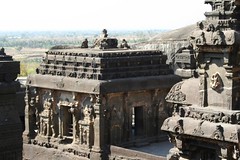
Click photo to see slideshow
or here for all Holy Caves pictures
When I first saw the incredible caves carved in the mountainside on Elephanta Island, my first thought was “What the hell were they thinking?” But touching as it was, that visit didn’t prepare me for the sight of the incredible Kailasa temple, the crown jewel of the Ellora archaeological site near Aurangabad – a magnificent Hindu shrine cut out of the mountain rock, complete with gate, courtyard, standing sculptures and side-galleries; a true awe-inspiring sight worthy of being counted among the architectural wonders of the world.
While in Aurangabad, we had also planned to visit the equally-famous Buddhist caves of Ajanta, but in good tradition we woke up late and lost the little steam that we had left in our engines as soon as we walked out of our hotel in the excruciating afternoon heat…
Agra
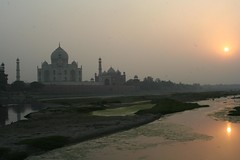
Click photo to see slideshow
or here for all Agra pictures
Taj Mahal entrance - Indian national: 10 rupees, foreigner: 1 million rupees… It’s not quite as high a number in reality, but the admission prices at national parks, museums and historic monuments are blown out of proportion for foreigners, and the Taj Mahal tops it all. Foreigners are charged more because they can afford to pay, and they do, but being told in the face “now’s the time when we take your money” is an experience I cannot ignore blissfully in a land where I am constantly asked to pay outrageous prices for every kind of goods and service. I’d be happier if I knew that the money went towards conservation and maintenance but I have a slight suspicion that given the precarious and derelict state of many historical landmarks, the dough will rather end up fattening some politicians and their wives…
It’s quite the irony that many of the masterpieces of Islamic architecture left by the Mughal Empire are located in the most god-forsaken, ugly, foul-smelling, nondescript city in the whole subcontinent. Agra is not only a place that’s impossible to enjoy on a visit - which may be an excusable deficiency, compensated by its abundance of famous monuments - it also has bad and uninspired food, and that is an unforgivable sin.
Don’t believe what the books say about the Taj Mahal changing colors at dusk and dawn with the setting or rising sun; it’s just a legend, deceiving many early risers and hopeful photographers - the famous marble monument to undying love is gray-whitish from morning till evening. The story of changing colors could be true only if Agra weren’t as polluted as it was when we visited - the sky was opaque and milky with smog all day; the thick, hazy air reduced visibility to no more than a mile ahead; the light was dull and discouraging for the many amateur photographers storming the gates at 6AM. Besides, my camera battery died shortly after sunrise. And then the spare decided to do the same…
Conclusion: do not stay overnight in Agra; you can visit the Taj Mahal, the fort and the other monuments during a day-trip from nearby Delhi.
Varanasi

Click photo to see slideshow
or here for all Varanasi pictures
There’s probably no other city in India that symbolizes Hindu spirituality at its fullest as much as Varanasi, the ancient holy site on the banks of the Ganges. Along the river ghats devotees bathe with fervor to free themselves of sins and bad karma, dipping in the murky sacred water, undeterred by the sewers which pour the filth of the city in the river, the ubiquitous cow shit, the floating garbage and the general poor sanitary conditions. Spirituality and religious devotion can obviously live apart from and unhindered by the modern western concerns about health, noxious bacteria and the microbiological purity of water.
Varanasi is also the temporary home to a large community of westerners, most of them sporting long dreadlocks and wearing clothes flaunting the “Om” sign in a variety of sizes and colors, meant to set them apart from the mass of regular tourists who are just “passing through”. They are the spiritual junkies in search for the ultimate redemption of the soul, and India is the supermarket where enlightenment and inner peace can be acquired and paid for in the currency of your choice: cash if you prefer the easy, chemical way, or hours of void-seeking meditation, passionate prayer to your favorite god, or selfless submission to a guru’s ashram rules. On the train from Agra to Varanasi we met an Australian guy who has been living in Varanasi with his wife and young son for the last two years. He was nice, helpful, with a wide congenial smile and talked casually; the only time I detected a slight tinge of smugness in his attitude was when he said, “You know, we’re big into this spiritual thing…” Like he belonged to the club of the selected few…
The average conversations between westerners, which we could occasionally overhear in restaurants located in the labyrinth of narrow alleys behind the Ghats, were more along the lines of “duuuude, I cannot even begin telling you how fantastic India is… it’s so aaaawesome! I can’t describe how spiritual I feel here, I don’t ever want to leave!” Uhm, yea, ok… can I have a puff of that spirituality please?
Posted from Railay, Thailand - and I still have things left to say about India...


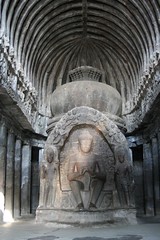

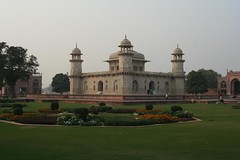
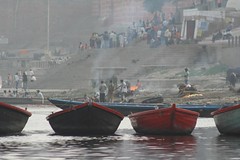
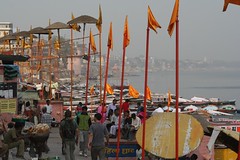

No comments:
Post a Comment